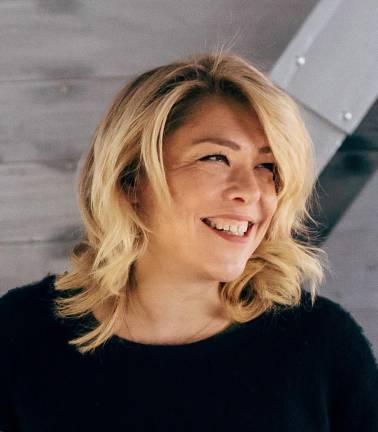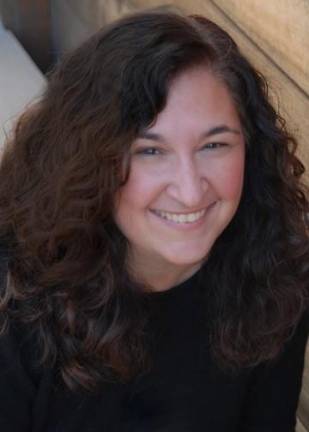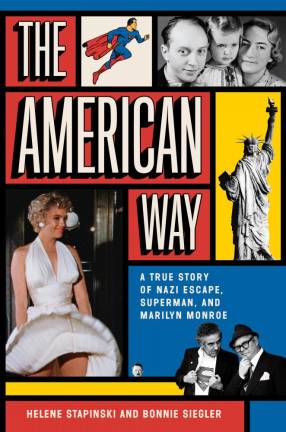Marilyn Monroe’s White Dress Billowed into Book about NYC and German History
Helene Stapinki and Bonnie Siegler the co-authors of “The American Way: A True Story of Nazi Escape, Superman and Marilyn dish on their fascination dive into connecting parts of the past.



When Bonnie Siegler was cleaning out her late grandfather Jules Schulback’s Upper East Side apartment in 2004, she happened upon a D’Agostino bag with film reels inside. One of them was footage he took of Marilyn Monroe filming the famous windy white dress scene for “The Seven Year Itch” on 51st and Lexington Avenue in 1954.
“It was mind blowing because of the white dress on the black background, you could see it crystal clear,” said Siegler, a Long Island native and graphic designer, of the then-50-year-old clip.
Ten years later, she connected with reporter Helene Stapinski, a native of Jersey City, who wrote an article about the iconic discovery in The New York Times. Through the piece, which went viral, Siegler connected with family members who helped to unravel their history. One compelling piece of information she learned was that Harry Donenfeld, the publisher of Superman, sponsored Schulback to immigrate from Berlin to New York.
With this new discovery, the duo decided to collaborate on a book together. Using resources such as Ancestry.com, the Superman archive at Columbia University, the United States Holocaust Memorial Museum and a trip to Berlin, the women penned “The American Way: A True Story of Nazi Escape, Superman, and Marilyn Monroe,” which was released in February.
Siegel said the timing of the project could not have been better. “The country changed, and hate was really normal,” she said. “There was so much antisemitism building and so it was the time to tell this story.”
Bonnie, tell us the story about your grandfather and the Marilyn Monroe footage.
Siegler: My grandfather shot 16-millimeter film often and I knew, growing up, that he had filmed Marilyn. And he would talk about it over the years. When he was evicted from his apartment [a foundation bought the building] and I was cleaning it out with my husband, in the back room, in a plastic bag, we found the film mixed up with lots of other film. It was like spaghetti. And we brought it home and put it up on a reel to reel and immediately saw it was the footage.
Stapinski: It was a D’Agostino’s bag.
Siegler: He lived on 61st and Lex, so there was a D’Agostino’s bag. [Laughs]
How did your partnership come about? I saw in the book’s Acknowledgements, you mentioned someone named Lisa DiMona.
Siegler: I’d written two other books. They’re design-related books. And I had this idea to write this article in The New York Times, so I asked Lisa, who was my book agent at the time, if she could recommend somebody. And she said, “Do I know somebody? I represent someone who writes for the New York Times, is amazing and you’ll love her.” And she introduced us and we met and fell in love and worked together from that day on.
Helene, when you wrote the Times piece, did you expect that kind of reception?
Stapinski: I did, because I’ve been a reporter for...I’m 58 and I’ve been writing since my high school newspaper and I’ve been freelancing for 30 years. So you hear a good story and you know it’s a good story. You just feel it in your gut. And so as soon as I met Bonnie and she showed me the footage of Marilyn Monroe on her phone and then started telling me the story about her grandfather and Nazi Germany, I was like, “Oh my God, this is amazing.” And so when I pitched it, I knew it was good. And then when they ran the footage, it was just a dynamite package. And it ran at the top of the homepage that Sunday in the Times. It went everywhere.
Siegler: It was also the Sunday before the inauguration of the last president. So it was a big news week and it was an amazing story that really stood out among the other stories at that time.
So at first, the Superman connection wasn’t mentioned?
Stapinski: And at that point, Bonnie didn’t even know the story about the Superman part of it. She had heard rumors that some guy involved with the founder of Superman had sponsored her family, but she didn’t know anything, so we didn’t include that in the original story. Because it would have taken months to research it, and we just wanted to get the story out. And so then that’s how the book came about, because she then found out.
Siegler: A cousin of mine, Neil Sternberg, called me and said, “I found something about the ship your mom came over on on Ancestry. Also, did you know that I went to the DC [Comics] offices with my mom?” And I was just like, “Who are you?” So I really didn’t know anything at that point. I mean that was like in the ‘90s. And then we started looking into it. I got more information. I started talking to relatives I didn’t know, partially because of the article, and they started filling in the blanks. And then, I was driven to really dig down and then I asked Helene if we could write a book since we now had these three pieces- my grandfather and the Holocaust, Marilyn Monroe and Superman.
There’s so much history in the book, so tell us about the research process.
Stapinski: We pretty much naturally just broke stuff up. Bonnie was doing all the family research. But we interviewed everyone together on Zoom. And this was all during the pandemic, by the way. We called each other like 100 times a day. We should have just had walkie-talkies. She would find something, get excited and tell me about it, and I would do the same.
Siegler: We have very different takes on things and putting it together was what really made it cool.
As far as Ancestry.com, how did you use that as a tool?
Siegler: I spent so much time on Ancestry. I love it so much. For example, we didn’t really know anything about Harry. I was able to find every time he and his mistress, not his wife, not his lover, took a boat to Havana. Every travel document is on Ancestry.
Tell us about the Superman archive at Columbia.
Stapinski: So Bonnie had read the Larry Tye book and it said all of his archives from that book were at Columbia. So we got in touch with Columbia; I had gone there, so I figured we’d just go to the library. But because of COVID, the library was closed. It’s like a comics archive that they have there. So the curator for comics and cartoons, Karen Greene, basically Zoomed with us and showed us every document one at a time.
And the Holocaust Museum also assisted you.
Siegler: The Holocaust Museum was incredibly helpful. They just kept sending us original Nazi documents and they connected us to this one office in Germany and they mailed to me about 200 pages of letters between my grandfather and my aunt [to the German government] asking for reparations.
Stapinski: And those had lists of what they left behind. So when we describe the apartment and what was in it, that’s how we know. It was a long list of the china and the silver. We used that to recreate what that place looked like. And then of course, we went to Berlin. And that filled in all these blanks in Jules’ life. We actually went to the places where he lived and worked and all of the buildings were still standing, which is a little bit of a miracle, because everything there was bombed.